Luigi Lavazza - coffee maker
From a grocery store in Turin to Italy's market leader
Luigi Lavazza, the Turin grocer who founded the Lavazza Coffee Company, was born on this day in 1859 in the small town of Murisengo in Piedmont. He had lived as a peasant farmer in Murisengo but times were hard and after a couple of poor harvests he decided to abandon the countryside and head for the city, moving to Turin and finding work as a shop assistant. The Lavazza brand began when Luigi had saved enough money to buy his own shop in Via San Tommaso, in the centre of Turin, in 1895. He sold groceries and provisions and where other stores simply sold coffee beans, he had a workshop in the rear of the store where he experimented by grinding the beans and mixing them into different blends according to the tastes of his customers. He travelled to Brazil to improve his knowledge of coffee and his blends became an important part of the business, after which he moved into wholesale as well as retail as a coffee merchant. When the first automatic roasting machines went into production in the 1920s, he was one of the first in Italy to buy one. The economic climate in Italy improved after the First World War. Read more…
_______________________________________
Giuseppe Panza - art collector
Businessman amassed more than 2,500 pieces
The art collector Giuseppe Panza di Biumo, whose fascination with postwar art, particularly American, led him to build up one of the world’s most important collections, died on this day in 2010 in Milan. A businessman who succeeded his father in making money from wine and property, Panza acquired more than 2,500 pieces in his lifetime, many of which he sold or donated to museums and art galleries. Some he parted with for millions of dollars, although he always insisted that his motivation was never financial gain but the love of art. Approximately 10 per cent of his collection remains in the 18th-century Villa Menafoglio Litta, his family home at Varese, north of Milan, where he created 50,000 square feet (4,600 sq m) of exhibition space. He had an astute eye for talent, often identifying unknown artists who would go on to become collectible long before their works commanded premium prices. For example, he anticipated the popularity of Minimalism in the 1960s, snapping up works by Donald Judd and Dan Flavin well before their careers had really taken off. Born in 1923 in Milan, Panza had a comfortable background. His father, Ernesto, was a wine distributor. Read more…
____________________________________
Giuseppe Marc’Antonio Baretti – author
Dramatic life of the ‘scourge’ of writers
Literary critic, poet, writer, translator and linguist Giuseppe Baretti was born on this day in 1719 in Turin, the capital city of Piedmont. His life was often marred by controversies and he eventually had to leave Italy for England, where the drama in his life continued and he was tried at the Old Bailey for murder in 1769. Baretti’s father had intended him to enter the legal profession but when he was 16 he fled from Turin to Guastalla in Emilia-Romagna where he worked in the import and export business. His main interest was studying literature and criticism but, after he became an expert in the field himself, his writing was so controversial that he eventually had to move abroad. Many students of Italian Literature are familiar with the name of Giuseppe Baretti as the writer, editor and proprietor of the fearlessly sarcastic periodical La frusta letteraria, which means Literary Scourge, in which he castigated bad authors. For a few years Baretti wandered from country to country supporting himself by writing. He was the author of two influential dictionaries, a Dictionary and Grammar of the Italian Language and a Dictionary of the Spanish Language. Read more…
_______________________________________
Alessandro Costacurta - long-serving footballer
AC Milan defender played in Serie A until 41 years old
Former Italy and AC Milan defender Alessandro Costacurta was born on this day in 1966 in the town of Orago, near Varese. Costacurta retired in May 2007, 25 days after his 41st birthday, having played more than 660 matches for AC Milan over the course of 21 seasons. He is the oldest outfield player to appear in a Serie A match. Milan lost his final game 3-2 at home to Udinese but Costacurta marked the occasion with a goal, from the penalty spot. It was only his third goal in 458 Serie A appearances for the rossoneri, but made him Serie A's oldest goalscorer. He could look back on a career laden with honours, including seven Serie A titles and five European Cups, two in its traditional knock-out format and three more after the inception of the Champions League. He also won 59 caps for Italy and was a member of the team that finished runners-up in the 1994 World Cup in the United States, although he had to sit out the final because of suspension. Costacurta made his Milan debut in the Coppa Italia in 1986 before being sent away to gain experience with Monza in Serie C. His first Serie A appearance came for Milan in October 1987. Read more…




.JPG)
_Gaspara_Stampa.jpg)


.jpg)

.jpg)




.jpg)



.jpg)
.jpg)








.jpeg)
